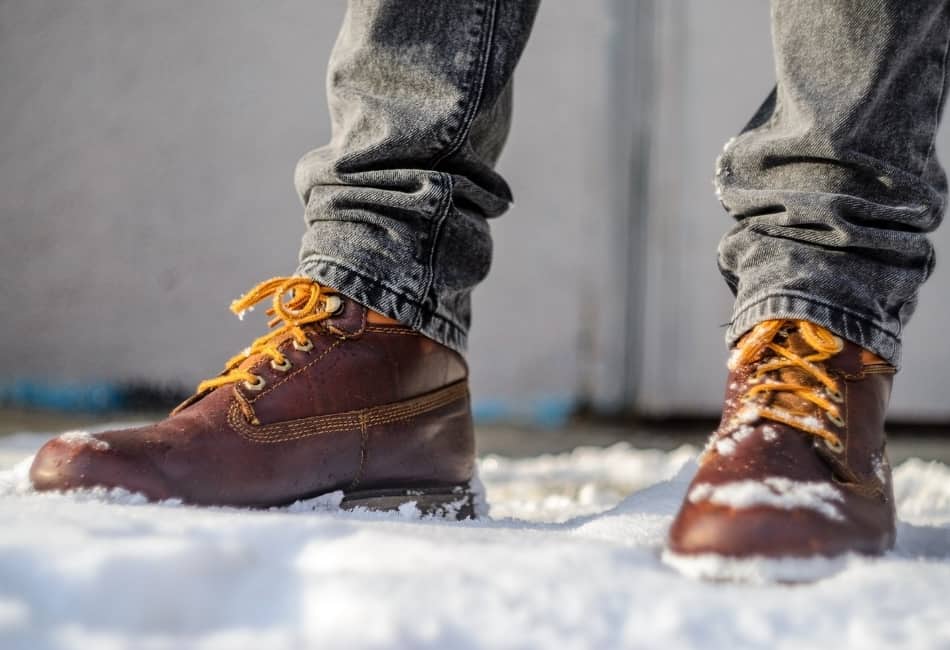The winter season is upon us and if you have leather boots, jackets or purses, then it is important to know whether the cold weather affects them or not. It will help you make the decision about what leather items, clothes, and shoes to use or wear on days with harsh cold temperatures so your favorite leather items last for years without any damage.
Generally, a well conditioned, nourished, and protected leather will adapt to the cold weather without any issues. The only way cold weather affects leather is by making the surface of the leather colder than the air temperature.
But if you have poorly cared for leather item(s) during the extreme cold weather the result is that the little moisture contained in the leather could turn into ice and form tiny crystals making the leather brittle or stiff and when the weather changes, the leather can crack or develop serious wrinkles.
The best way to avoid this cold weather damage is by keeping your leather well conditioned, nourished and protected at all times with high quality leather care products like Leather CPR.
Here’s How Cold Weather Affects Leather
So as you can see the issue of whether cold weather can affect leather items is a relatively yes and no answer.
If your leather is in good condition and protected then the cold weather will not affect it at all, but if you have neglected to properly care for your leather items then it can be very damaging during harsh cold temperature changes.
So here are 4 cold weather affects leather and tips to help you make informed decisions about how to care for your leather items during the winter season.
1. Leather Feels Extremely Cold In Low Temperature
Leather will often feel cold even with very minimal amount of exposure to the winter air. This will happen with or without proper care and it is because leather is a good conductor or heat.
Generally, our skin perceives anything that conducts heat away from us as cold and this will usually happen due to heat from our skin.
So regardless of whether you have conditioned or protected your leather, it can still feel very uncomfortable when exposed to low temperatures.
So for leather items like car seats, seat warmers are often installed to help regulate the temperature and avoid the cold feeling.
2. Cold Weather Can Cause Wrinkles On The Leather Surface
If your leather is not properly conditioned, then the cold weather can cause wrinkles on the surface.
This happens because leather usually stretches out slightly when the weather is warm and then contracts again when the weather is cold.
If your leather has not been conditioned it won’t shrink back to its original size or properly cope with the changing temperatures and can results in a wrinkly surface on your leather.
It will also have an effect on seams, stitching and other areas where there are creases or folds as well.
So you want to make sure that your leather is conditioned and nourished and that the temperatures around your leather is properly regulated to avoid wrinkles.
3. Extreme Cold Weather Will Dry Out Leather
Leather can withstand extreme cold weather if it has been properly conditioned, but if it has not then the cold weather can dry out the leather.
The way this happens is the extreme cold weather allows water particles to form within the pores and fibres of the leather which otherwise should have been filled with moisturising oils.
And once water sits in the fibre of leather for a really long time it can start to cause damage and smells like mold or mildew when the temperatures gets back to normal.
So extreme cold weather can be bad for leather if it’s not conditioned, and you want to make sure that your leather is well protected against moisture and extreme cold.
4. Moisture In Leather Attracts Salt In Cold Weather
We all know the amount of salt that is used on the roads in order to prevent ice and snow from accumulating.
But what you may not know is that this salt can also be very damaging to leather.
The salt will start to accumulate on the surface of the leather and if it is not removed, it can cause the leather to deteriorate and crack.
In the winter, it’s important to make sure that you clean any salt off your leather and also avoid any salt-water exposure.
Salt water is particularly bad for leather so make sure to avoid it during winter months.
How To Prepare Your Leather Items For The Cold Weather
Now that we have a good idea of what happens to leather in cold weather, let’s talk about how you can prepare your items before the winter season.
Clean Your Leather Before Hand
Before the winter or cold weather you would want to clean your leather with a good quality cleaner.
This would remove any dirt or stains on the surface of your leather and also help free the pores of the leather from any type of dirt and stains that might clog it up.
If you don’t clean your leather before the cold weather, then any dirt on the surface will only make things worse in the sense that the stains could become permanent.
Condition Your Leather Before The Cold Weather
After you have cleaned your leather, the next step is to condition it before the cold weather.
Leather needs to be conditioned every few months even if it’s not exposed to cold weather.
But you need to make sure that you condition your leather before the winter hits because the cold weather can really dry it out.
There are many different types of leather conditioners that you can purchase, or you could even make your own.
But the main idea is to nourish or moisturise your leather so that it can withstand the cold weather and not dry.
Apply a Protective Product To Your Leather
Once your leather is clean and conditioned, you would then want to apply a protective product.
This will help seal the pores of the leather and protect it from any type of moisture or water that might come in contact with it.
There are many different types of protective products that you can purchase, but make sure to read the instructions carefully so that you apply it in the correct way.
If you don’t apply a protective product to your leather, it can become damaged very easily from the cold weather.
How To Take Care Of Leather During Cold Weather
Now that we have talked about how to prepare your leather items for the cold weather, let’s talk about how you should take care of them while in the cold weather.
Monitor The Temperature Around Your Leather
Finally, make sure to monitor the temperature around your leather. This means that you should avoid exposing it to extreme cold weather.
It’s a good idea to move you leather items indoors before the temperature drops below. You should also regulate the temperatures around your leather items.
Remove Salt Build Up Regularly
If you happen to get salt build up on your leather, make sure that you remove it as soon as possible. Salt build up will cause the leather to deteriorate and crack.
You can remove the salt by using a wet cloth and gently rubbing it off the surface of the leather.
Be very careful not to scrub too hard as this could damage the leather. Now that we have a good understanding of how to care for your leather during the colder months, let’s recap some key points.
Use a Protective Product on Your Leather
First and foremost, you would want to make sure that you apply a protective product on your leather.
This will help seal the pores of the leather and protect it from any type of moisture or water that might come in contact with it.
There are many different types of protective products that you can purchase, but make sure to read the instructions carefully so that you apply it in the correct way.
Condition Your Leather Regularly Throughout the Year
Also, you would want to condition your leather regularly throughout the year – not just when cold weather is approaching.
Leather needs to be conditioned every few months even if it’s not exposed to cold weather.
But you need to make sure that you condition your leather before the winter hits because the cold weather can really dry it out.
There are many different types of leather conditioners that you can purchase, or you could even make your own.
But the main idea is to nourish or moisturise your leather so that it can withstand the cold weather and not dry out.
Final Thoughts
I hope that this article has been helpful in teaching you how to take care of your leather during the colder months.
Make sure to follow these tips and your leather items should last for many years. Thanks for reading.

